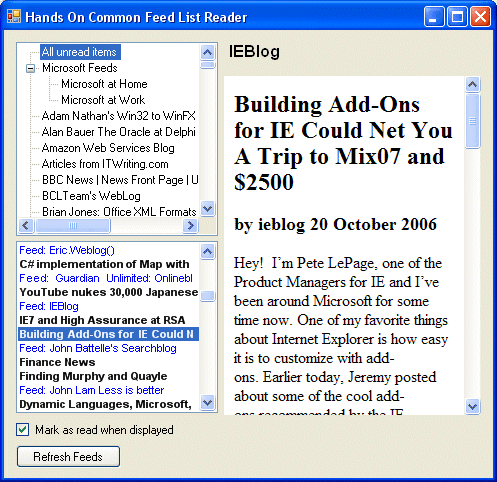I am not going to say too much about this right now; if you want to know how it is put together you can always subscribe to Personal Computer World. But it has solved most of my problems with the IE7 RSS reader. Hey, maybe I’ll go for that $2500…

I am not going to say too much about this right now; if you want to know how it is put together you can always subscribe to Personal Computer World. But it has solved most of my problems with the IE7 RSS reader. Hey, maybe I’ll go for that $2500…

I’m now 24 hours into my attempt to use IE7 in place of my previous dedicated blog reader. It’s tolerable, but only just.
On the positive side, feeds are neatly presented and work well with IE7 tabs. If you want to read the full text or comments for a post, right-click the header and choose Open in New Tab. This is particularly handy for slow pages; you can carry on reading the feed while the all the ads and stuff on sites like news.com open in the background in the new tab.
So what’s wrong with it? The biggest problem is that IE7 has no real concept of a feed item. It must be there internally, but it isn’t exposed. This messes up the management of read/unread items. You cannot mark an item as read or unread; you can only mark a feed as read. For example, say you select a busy feed like Engadget and there are 6 unread items with those large shiny images scrolling well out of sight down the page. The top item catches your eye, so you click it to read. IE7 now considers all the other items as read as well – unless you remember to unselect “Mark feed as read” every time. As a result, you are very likely to miss some items if you use IE7 for feed reading.
Next snag: there’s no way to search feeds. This turns out to be problem with the underlying RSS platform. Unless I’ve missed it, there are no methods for searching feeds; you have to iterate through each item and search in your own code. I presume that means that the centralized RSS store has no full text index, which is a shame. Anyway, IE7 has no such feature, so if you think to yourself, “I saw that in a blog this morning…”, but can’t remember which, then you have to turn to Google or Technorati.
Third, you cannot get a single view of all unread items. This is silly, as it is almost a defining feature of an offline blog reader: “Show me my unread items”. Instead, feeds with unread items are bolded, and you have to click each one to read. Lots of mouse clicks, not nice.
Fourth, it’s difficult to organize your feeds. Feeds sort themselves alphabetically, though sometimes you have to exit and restart IE7 to sort the sort. You can drag-and-drop feeds in the list, except you can’t, because although IE7 draws a horizontal bar showing where the feed will be dropped, it doesn’t drop there at all. It goes to the bottom of the list, and re-sorts alphabetically when you next restart. You can create subfolders, but you can’t select a group of feeds and move them between folders; you have to do them one at a time.
Maybe Microsoft doesn’t really want you to read RSS feeds in IE7. Perhaps the idea is that you buy Outlook 2007, which also uses the RSS platform.
The only bright spot is the API. I was so annoyed about the folder management that I ran up VB6 and wrote some code to move all the items in one folder to another. It worked sweetly. Perhaps I will write my own blog reader; I am sure the community will soon come up with some handy RSS platform readers and managers – maybe there are some already?
I’ve upated my Delphi sample for using Amazon S3; this time I’ve put the exe up for download so anyone can try it (if you have an S3 account).
If there is interest I might work this up into a more user-friendly utility; or perhaps someone would like to help with this.
It does many of the essentials: file upload and download, progress report with cancel option, create, delete and list buckets and items.
http://www.itwriting.com/s3.php
Tim
I upgraded to Internet Explorer 7.0 on three machines this morning. I have to say the experience was very smooth, though not especially quick. You have to pass a validation dialog as well as a new licence agreement, so I guess there are hassles if Microsoft decides your not on “Genuine Windows”; but plenty has already been said on that subject.
IE7 is long overdue and probably won’t wean many off Firefox, but it’s a decent upgrade, with tabbed browsing perhaps the number one feature; of course FireFox has had this since its first release. Even if you use Firefox, I’d still be inclined to upgrade to IE7 simply because it’s pretty much a system component. You may not use it for browsing; but embedded IE will likely still turn up in a few apps you use. Web developers will need it for testing if nothing else.
I’m particularly interested in the centralized RSS platform which comes as part of IE7. I’m a satisfied user of Omea Reader, which is superb and deserves more attention than it gets; but I really like the idea of a single feed store in the OS, so I thought I should try migrating to IE7. First question: can IE7 import an OPML feed list? It turns out that it can, but the feature exposes some silliness in Microsoft’s new browser.
You see, Microsoft has gone for a clean look with no menu by default, just a few icons and an address bar. Unfortunately, this means there is significant functionality hidden by default, and finding it is not particularly intuitive. In this case, you have to click the Tools drop-down and select Menu Bar, then choose File – Import and Export, then choose Import Feeds.
It worked, I’m glad to say, and now all my subscribed feeds are in IE7. However, now that I’ve realised the importance of the Menu Bar I don’t want to hide it again, so I’ve lost the clean look; in fact, it feels odd having the menu bar below the address bar and I wish I could put it at the top where it belongs.
Will I be able to live with IE7 as a feed reader, or go running back to Omea in a day or two’s time? I’ll let you know.
Finally, a note for any Borland developers reading this. If you use Borland Developer Studio, you need to update the registry to avoid access denied errors with ASP.NET. See Resolving Access Denied errors in the BDS ASP.NET designer with IE7 installed.
Update: A comment to this blog tells me that import and export is also accessible through the Add to favorites icon. So showing the menu bar is not essential after all; it’s just a bit obscure as I’d presumed that Add to favorites only does what its name implies.
Joe Morel blogs about users of MSDN Forums, the official discussion groups for Windows developers. He has stats which show that 98.5% of the forum’s users are lurkers (they read but do not post), that nobody like logging in and only do so when forced (because they want to post), and that most people find the content through Google rather than because they are consciously participating in an online community.
This is more or less what I noted back in August, but it’s good to see the confirming stats.
Google helps; but many sites still have not learned the principles which Morel outlines.
A side-effect of migrating this blog to WordPress is that I can now use Windows Live Writer to author posts. It’s a great little app, as noted today by James Governor, and has been favourably reviewed around the web since its first public beta in August (though I wish the team would add spell checking in languages other than US English). This review by Phil Wainewright is my favourite, because it gets the strategic potential. In addition, if Microsoft can get us hooked on Writer, we’re more likely to start using other Live services like Maps – Writer has “insert Windows Live Map” on its menu bar – which ultimately results in more Live traffic and ad income.
A snag with this grand scheme is the poor performance of Microsoft’s Live properties. For me, Live Writer works much better with WordPress hosted on my own site than with the Windows Live Space that I’ve set up as a trial, purely because Spaces is so slow. Live Local Maps is tardy too. As for the Live plugin gallery, this is what I get right now:

This is where Google scores so highly. It is not immune to problems, but most of the time it is remarkably responsive, whether for Search or Maps or other services.
I sometimes wonder if the folk in Redmond with fast local links just don’t see these performance issues. It not just me though: here’s the A9 report on Live Spaces:

I don’t mean to be negative. Writer is excellent, and offers a better user experience than any browser-based editor that I’ve seen.
Tags: livewriter microsoft .net live.com
There’s a debate under way about whether the new Apex language from Salesforce.com represents a vendor lock-in. Sinclair Schuller says it does; David Berlind says mostly not. Berlind argues that the lock-in is mitigated since you are not forced to use Apex, but can use the same functionality via SOAP web services. I recently wrote a comment on the same topic for IT Week.
I have mixed feelings on the subject because Apex is such a great idea. To write code that runs on a web server today, you have to go through a procedure that starts with learning a language, whether PHP or Java or C# or Ruby or Perl, along with some kind of web framework. Then you have to figure out how to test and deploy your code to a web server, hopefully giving some consideration to security issues along the way.
With Apex, the process is simplified. Instead of writing an app offline and then working out how to deploy it, you can write the code within a web form and deploy it by clicking a button. If Salesforce.com has done it right, the security risks are much less than with a conventional web app. By the way, you would normally work on a test copy of your live application so you do not have to inflict your buggy work-in-progress on your users. Salesforce.com handles all the difficult choices about which app server to use, and keeping it patched and up-to-date.
It’s possible that Apex and technologies like it may do for web app development what blogging software has done for web content authoring, opening it up to a larger community, and improving productivity for existing skilled professionals.
Although Apex calls the same internal APIs that are exposed through web services, it has the potential for much better performance. Consider the scenario where you want to loop through 100,000 records in code. Doing that with web services will take an age; in fact, that sort of operation is not what web services are designed for. Apex can do it though. The implication is that although you can choose between Apex or Web services, the Web Services choice will not always be viable. Another factor, as I understand it, is that Apex code can be triggered by server-side events, functionality which cannot be replicated through the web services API. The choice which Berlind notes may not be so free after all.
Is Apex lock-in? I think it is. Build your app in Apex, which is a proprietary language, and you will not be able to take it elsewhere without considerable pain and of course porting the code.
That doesn’t make it bad. The industry lives with vendor lock-in. It may still be worth it.
At the same time, this is surely the primary question you have to ask before embarking on a major Salesforce.com deployment. Do you trust Salesforce.com to keep its subscription charges reasonable, its servers running satisfactorily, its technology competitive, now and for the forseeable future? A competitive advantage could transmute into a significant disadvantage if Salesforce.com were to run into problems.
Tags: salesforce.com apex
Microsoft’s updated browser is released next week, and will be distributed via automatic update from November 1st.
It is three years late. Here’s the release history:
On a (reasonable) two year release cycle, we should have had version 7.0 in 2003. Let me add that version 6.0 was really a disappointment; more like version 5.1 in some ways. Microsoft won the browser wars, then stalled the progress of web standards for five years. It was the growing popularity of Firefox, released in November 2004, that persuaded Microsoft to restart development. There would in any case have been some sort of update in Windows Vista; but without the open source competition I doubt it would have amounted to much.
The history leaves a bad taste and makes it hard to enthuse about IE7. Nevertheless, it is a badly-needed update. I’m inclined to leave the blow-by-blow comparison with Firefox to others.
The one piece I can enthuse about is the centralized RSS store that comes as part of IE. This makes a lot of sense and I’m looking forward to it.
A few comments on Google + YouTube:
While reseaching a piece in today’s IT Week, I checked out several prominent home pages in the W3C Markup Validation Service. There wasn’t room for all the results in the piece, so I’m posting them below, best to worst:
Disclaimer: This was early last week; the exact figures will have changed by now. I found it interesting that only IBM managed a pass, others such as Microsoft and Sun are clearly trying to comply, while the likes of MySpace, eBay and Amazon apparently could not care less.
Does anybody care? Mostly not; all we care about is web sites that work in our favourite browser, though in theory there is a connection between the two. Which was the point of my article: the W3C seems to be of decreasing relevance these days.
Still, kudos to IBM.